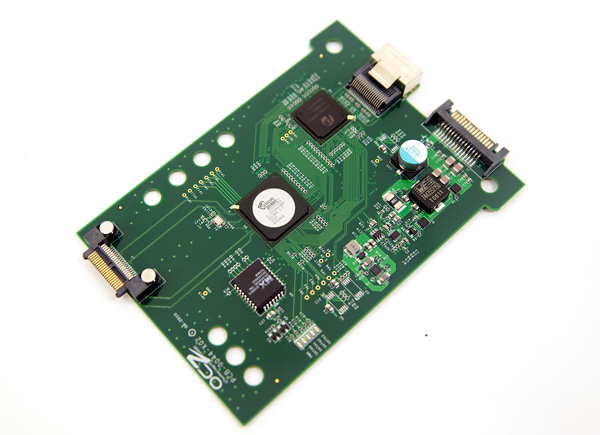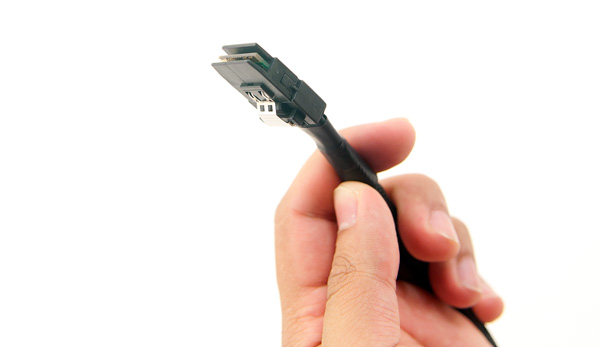OCZ's Fastest SSD, The IBIS and HSDL Interface Reviewed
by Anand Lal Shimpi on September 29, 2010 12:01 AM ESTFinal Words
The OCZ IBIS is very fast as you’d expect. Technically it’s the fastest SSD we’ve ever tested, but that’s because it’s actually four SF-1200 SSDs in a single 3.5” chassis. From a cost standpoint you’re better off grabbing four SandForce drives and rolling your own RAID, but if for whatever reason you don’t want to do that then a single IBIS will get the job done. It's faster than a Colossus by a huge margin and even faster than OCZ's recently introduced RevoDrive, you just need the workload to stress it.
I’m very comfortable with SandForce as a controller when it comes to not having TRIM. The IBIS’ garbage collection is aggressive enough to fix any significant fragmentation with a bit of idle time.
As I mentioned earlier however, the real goal here is to RAID multiple IBIS drives together with the 4-port card. We measured maximum sequential throughput of 675MB/s for a single IBIS drive, assuming somewhat linear scaling you can expect over 2.5GB/s out of a 4-drive IBIS array. This would be all off of a single PCIe x16 card. At this point the 4-port cards aren’t bootable, OCZ believes it is still several weeks away from having that support enabled.
Introducing a new interface is a very bold move for a company whose start was as just another memory vendor. I asked Ryan if motherboard manufacturers were signed up to deliver boards with HSDL connectors, he said they were. Although motherboard manufacturers often agree to do a lot that doesn’t end up being a launched, retail product. Motherboard makers aren’t the only ones who have taken notice as apparently RAID card manufacturers also want a piece of the HSDL pie. All of this is completely up in the air at this point. It’s one thing to mention you have lots of interest, it’s another to point at a mature market with products actually launching. Getting any company, much less a motherboard or RAID card manufacturer to commit resources to delivering features that support a market of zero is a tall order. I’m not saying it can’t be done, I’m saying that if Ryan Petersen can achieve it, he will have been the first to do it among a long list of memory companies who tried to be something more.
Ryan and OCZ are doing what they’re good at: finding a niche and trying their best to get there quicker than the big guys. There’s simply no PCIe SSD standard for the high end. For a single PCIe SSD there’s not much need, but if you want to RAID together multiple PCIe SSDs you’ll either run out of PCIe slots or have a very fast, very unbootable RAID.
The HSDL standard is completely open. OCZ tells me that there’s no licensing fees and all companies are completely free to implement it. In fact, that’s what OCZ would like to see happen. Currently the only way to get the HSDL spec is to contact OCZ and request it but the company is apparently working on setting something up a little more open. At the end of the day OCZ still wants to make money selling SSDs. HSDL’s success would simply let the company sell more expensive SSDs.
Drives will be available in two weeks but let's hope some of these integrated motherboard designs pan out.
HSDL sounds like a simple solution to the problem of delivering more interface bandwidth to SSDs. The interface should scale well since it’s built on PCIe, it’s just a matter of whether or not companies will support it. I believe it’s at least worth a try.












74 Comments
View All Comments
mroos - Friday, November 5, 2010 - link
What PCI device do these IBISes provide? Is it something standard like AHCI that has drivers for every OS, or something proprietary that needs new driver written and integrated into all relevant OS-es?mroos - Friday, November 5, 2010 - link
OK, it looks like the interface to host is SiI 3124. This is widely supported sata HBA and has drivers for most operating systems.But SiI3124 is just SATA host controller - no RAID. So the RAID must be done host side, or sofRAID in other words. It also means Linux should see 4 distinct SSD devices.
paralou - Saturday, April 9, 2011 - link
Hello,I don't remember if i already posted my question, sorry !
But in installed one IBIS 160GB using the following configurated computer:
ASUS P6T WS Pro (latest BIOS & drivers)
Intel i7 Core 965 Extreme 3.2GHz
Kingston DDR3 1600MHz - 12GB
nVIDIA Quadro FX4800 grphics card
2 Seagate SAS 450GB
Microsoft Windows 7 Pro
After installing Win7 without problems, i installed antivirus BitDefender, several app's (including Adobe package and Microsoft Office Pro), configured Updates NOT AUTOMATIC !
When i stopped my computer, system started downloading 92 Upgrades (without my permission) ?
When i restarted..Crash error 0x80070002
Impossible to restor (i made an image system, but day before !)
Reinstalled, and while i was typing the Key codes for the Microsoft Vision Pro ..
An other crash ! Same problem !
My opinion, about the IBIS HSDL box, it's a very poor assembly design!
Impossible to connec the supply connector on it, and i must dismantle the front plater to have access to the supply connector !
Now, i wonder if i have to follow OCZ's advice about the BIOS configuration?
They are saying:
" You must set you BIOS to use "S1 Sleep Mode" for proper operation.
Using S3 or AUTO may cause instability ".
And what about the internal HDD's ?
Is there any member who already installed such IBIS and use it regularely.
If the answer is Yes (?) can you please tell me how you configured your system ?
Regards,
Paralou
MySchizoBuddy - Wednesday, February 22, 2012 - link
OCZ doesn't have PCIe x16 option like FusionIO ioDrive Octal which takes the reads to 6GB/s